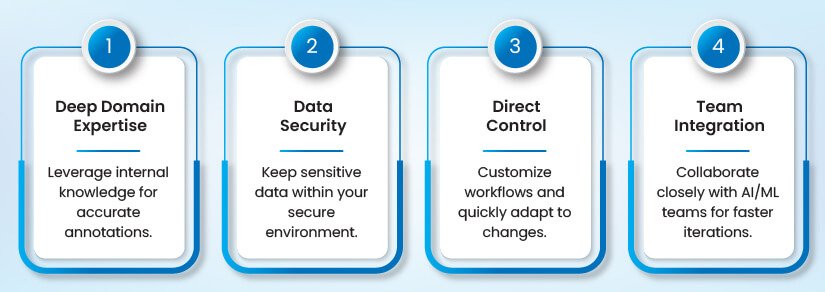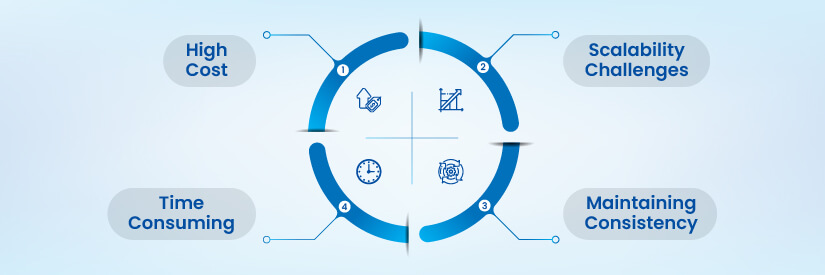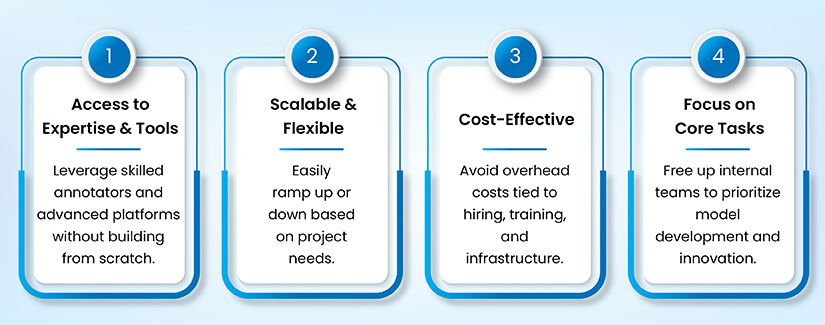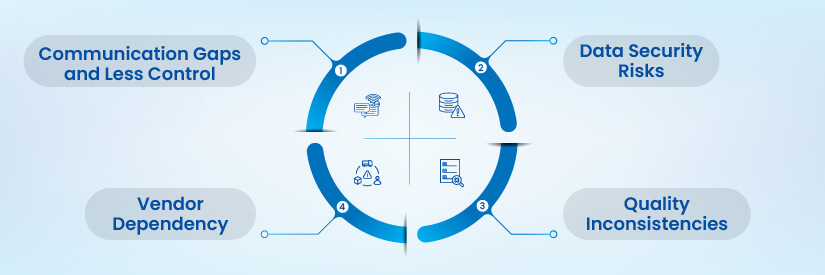- In-house dataset creation allows more control and confidentiality but requires more resources and domain expertise.
- Outsourcing is best suited for repetitive and high-volume tasks as it provides scalability and cost efficiency.
- Based on project complexity, data sensitivity, and project goals, decide on the right approach.
Table of Contents
With the use and development of AI applications witnessing explosive growth, the need for targeted and accurate AI training datasets has gone up. Reflecting the trend, reports claim the AI training dataset market is expected to grow at a CAGR of 21.9% from 2025 to 2030, hinting at a vacuum that AI training data services are stepping in to fill.
Businesses still sitting on the fence, stuck between deciding whether to build datasets in-house or outsource to experts, get late in rolling out applications.
Both approaches, building AI training datasets in-house, and outsourcing to AI training data services, come with their pros and cons, and the first challenge lies in choosing the option that suits your business and workflows best.
To help you tackle that issue, we have taken a deep look into both dataset-building approaches, compared their cost, quality control mechanisms, and other factors, so you can take a final call. Read on for complete details.
Why AI training datasets matter
AI training datasets matter because they are the base that AI models use to learn. This helps them make accurate predictions. The kind of input data you use directly affects the performance of your AI models. Thus, accurate and contextually relevant AI training datasets are the key to a successful AI model. Poor-quality data comes with multiple risks. Apart from wrong predictions, it can also lead to ethical challenges.
Therefore, it is important to invest in an AI dataset. Whether you decide to go for in-house AI training data development or outsource AI training data solutions, make the choice after exploring all of your options and understanding in detail the advantages and disadvantages of both options.
Building AI training datasets in-house: pros, cons, and challenges
In-house AI dataset creation is a great option only if you can spare a dedicated team of experts and have the tools and infrastructure in place. You will need to have a complete workflow of data acquisition, annotation, quality-checking mechanisms, security compliance, and other such processes in place. Managing these processes internally often leads to significant data preparation challenges that can affect timelines and model accuracy. While it does offer many advantages, it also has limitations. Let us explore in depth the advantages and disadvantages of doing this in-house.
Advantages of building in-house datasets

Deep Domain Expertise – A deep understanding of the industry is most important in the development of AI datasets, and this is the most important advantage of using an in-house team. The internal team understands the industry, applications, and intricate details that help build contextually relevant and accurate datasets. This is especially helpful in specialized industries like healthcare.
Direct Control and Customization – Direct Control helps organizations keep the annotation process in line with internal goals, quality guidelines, and confidentiality requirements. It helps with customization and makes changes to the lifecycle of the process. Based on any requirements or unexpected challenges, you have the flexibility to immediately take a call and change the process.
Data Security and Confidentiality – Certain industries like medical imaging, finances, government, and defense, etc., deal with highly sensitive data. A high level of security and confidentiality is the need for such industries, and any breach can prove detrimental to the organization. Therefore, doing this process in-house minimizes the chance of any data leakage.
Seamless Integration with Development Teams – The AI dataset creation team and the development team work together to develop a successful AI model. Now, if dataset creation is outsourced, there could be project delays. You could lose time in communication and collaboration. On the other hand, if both teams work in-house, there could be better understanding, collaboration, and immediate resolution of issues related to data.
Disadvantages of building in-house datasets

High Costs and Resource Allocation – Building an in-house team has many implications, and the most important one is the cost factor. You will have to be prepared to invest a good amount in resource allocation, infrastructure, and tools. And most importantly, you will need to keep training and updating to keep aligned with advancing tools and technology. Quality control and feedback mechanisms are also important and would need investment in that area as well. Moreover, you will need a manager to oversee the entire project.
Scalability Challenges – If your project demands fluctuate, then having an in-house team may not prove cost effective. A sudden increase in work volume may put you under stress, and you may have to struggle with small resources and infrastructure. On the other hand, having a large-scale operation may go to waste if your work volume remains low. In such a scenario, outsourcing AI dataset creation can help you scale up and down based on your work volume.
Maintaining Data Quality and Consistency – Maintaining consistency and accuracy in AI training datasets requires expertise and specialized processes. Internal teams with domain expertise may not have the expertise to manage standardized guidelines and quality control mechanisms. This can impact the performance of your AI models. Outsourcing experts have the right expertise to handle this. They have processes in place that take care of internal biases and inconsistencies.
Time-Consuming and Labor-Intensive – AI dataset creation is a time-consuming task. Internally trying to do this may take away your major chunk of resources and infrastructure and put stress on your internal team. Moreover, spending too much time on this repetitive task often diverts focus from the main task of AI model development.
Outsource Smart, Scale Faster
Reduce overheads and meet tight deadlines with expert data services
Outsourcing AI training datasets: pros, cons, and pitfalls
Hiring or partnering with a third party for any task that could be done internally is the latest trend, followed by many organizations. With the availability of many specialized AI training dataset service providers, it is often a prudent call to avail the services of experts. Outsourcing does offer many advantages but has its drawbacks too. You must evaluate all the pros and cons and then take a call based on your project needs.
Advantages of outsourcing dataset creation

Access to Specialized Expertise and Technology – AI dataset service providers are competent in the field and have worked closely with diverse industries. This makes them a good choice for outsourcing your AI dataset creation. Years of experience and access to specialized tools and techniques, along with robust quality check mechanisms, make them an ideal choice to get your job done. Creating such a setup with skilled annotators and advanced technology often becomes challenging and may not work cost-effectively if done in-house. For instance, if you require a dataset for fine-tuning an LLM, service providers specializing in NLP annotation can better handle your project.
Enhanced Scalability and Flexibility – Outsourcing partners often work globally and have the infrastructure to scale operations up or down based on project demand. So, if you have a fluctuating workload, you will benefit from using the services of such partners. Doing dataset creation in-house would put you under a lot of pressure in case of unpredictable data requirements. You will have to rush to do fresh recruitments to meet deadlines. With outsourcing, you don’t have to bother with such issues, and you can focus on your core tasks.
Cost-Effectiveness in Certain Scenarios – Outsourcing proves cost-effective, as you avoid expenses related to hiring, training, managing skilled resources, and maintaining infrastructure. Vendors typically offer scalable teams and prebuilt workflows, which reduce ramp-up time and operational costs. A client saved 50% on project cost by opting for an offshoring model.
While overall costs may vary based on project complexity, data type, and required expertise, outsourcing eliminates fixed overheads, turning them into predictable project-based expenses. This is particularly advantageous for short-term, high-volume, or highly specialized annotation tasks where building in-house capacity isn’t feasible or efficient.
Focus on Core Business Activities – When you offload your time-and labor-intensive tasks to an outsourcing partner, you are better able to focus on your core tasks. Even your internal resources can better focus on strategies and contribute to company growth overall. The company can better utilize its internal resources.
Disadvantages of outsourcing dataset creation

Potential Communication Challenges and Loss of Direct Control – When separate teams work on dataset creation and AI model development, there are chances of communication gaps and misunderstandings. Lack of direct communication often slows down the iteration cycle, and issues that could have been solved instantly with an in-house team often take more time.
Data Security and Confidentiality Risks – If you are dealing with sensitive data, it is important to ensure that your service provider follows stringent security protocols. Letting out sensitive data to third parties could be risky if they don’t follow strict security protocols. Reputed vendors follow strict good practices to manage sensitive data, but this may not be the case with all service providers.
Quality Control and Consistency Challenges – While outsourcing service providers follow quality assurance and ensure data consistency, sometimes this can be challenging. Annotators across different locations may interpret guidelines differently, which could lead to inconsistencies in labeling. Cultural differences also lead to inconsistency in labeling. For example, an annotator in Europe will tag a hoodie with jeans as ‘casual’, while another in Asia would tag the same outfit as ‘leisure’.
Dependency on External Vendors and Potential Lock-in – When you outsource dataset creation, you often end up depending heavily on the vendor’s tools, people, and processes. At first, it may seem efficient, but over time, switching providers can become tough. You might face challenges like having to retrain a new team, losing annotation history, or dealing with tool incompatibility.
If the vendor changes pricing, struggles to scale, or their quality drops, your project could suffer. That’s the risk of vendor lock-in, where you feel stuck with a provider, even if things aren’t working well anymore.
Hybrid approach – best of both worlds?
A hybrid approach lets you balance control and scalability—your in-house team defines the strategy and quality checks, while an external partner efficiently handles high-volume, routine annotation tasks.
| When to Choose In-House Dataset Creation | When to Choose Outsourcing |
|---|---|
| For sensitive or compliance-bound data | For large-scale or repetitive annotation tasks, |
| If you have strong domain expertise and QA teams | When you lack in-house bandwidth or expertise |
| When tight collaboration with internal ML teams is needed | To save time and reduce operational overhead |
Conclusion
How you decide to build your AI training dataset depends on multiple factors. Whether in-house, outsourced, or a mix of both is a big decision that can shape the success of your entire AI journey. You need to check the complexity of your project, the sensitive nature of your data, your budget, and your scalability angle. There is no single rule to reach a decision. It all depends on your unique needs and your AI goals. Look into all points carefully, and make decisions that will support your long-term vision.
Build Smarter AI with Reliable Data
Focus on innovation while we handle the annotation complexity







